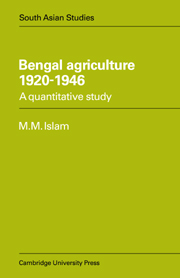Book contents
- Frontmatter
- Contents
- List of tables
- List of figures
- Foreword
- Preface
- Introduction
- PART ONE
- 1 Nature of crop statistics and revision
- 2 Trends in output, acreage and yield: all-crops, food crops and cash crops
- 3 Trends in output, acreage and yield: individual crops
- PART TWO
- Conclusion
- Appendix: statistical tables
- Select bibliography
- Index
1 - Nature of crop statistics and revision
from PART ONE
Published online by Cambridge University Press: 15 December 2009
- Frontmatter
- Contents
- List of tables
- List of figures
- Foreword
- Preface
- Introduction
- PART ONE
- 1 Nature of crop statistics and revision
- 2 Trends in output, acreage and yield: all-crops, food crops and cash crops
- 3 Trends in output, acreage and yield: individual crops
- PART TWO
- Conclusion
- Appendix: statistical tables
- Select bibliography
- Index
Summary
The quality of the basic core of statistics is of primary significance in any quantitative study. But it is in this respect that students of Indian agriculture have been faced with their greatest problem. Statistics had been collected in India in the pre-British period, but it was only in the second half of the nineteenth century that government interest in famine control and in the commercial needs of India led to the creation of a Department of Agriculture, which addressed itself, at least in its early years, primarily to the task of compiling reliable statistics, as this was recognised to be the first step in the direction of agricultural development. But it is generally believed that, in spite of this long history, agricultural statistics for all parts of India in general and those of Bengal in particular are unreliable. Thus, according to the Royal Commission on Agriculture ‘these are merely guesses, not infrequently manifestly absurd guesses’. Similar views have been expressed by various other official bodies and individual authors. Most of them have not, however, referred much to quantitative evidence and their opinions are based on considerations of the defects of the primary agency which collected these data and the methods it used.
In this chapter it is proposed to examine the basis of these beliefs and discuss some of the methodological problems. Could it be argued that the estimation of the different components of crop-output was influenced by the subjective judgement of the reporting agencies even more than usually supposed and, therefore, the officially published data are likely to be more unreliable?
- Type
- Chapter
- Information
- Bengal Agriculture 1920–1946A Quantitative Study, pp. 19 - 48Publisher: Cambridge University PressPrint publication year: 1979



